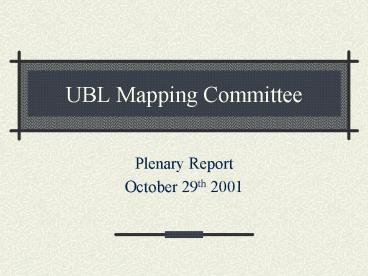UBL Mapping Committee - PowerPoint PPT Presentation
Title:
UBL Mapping Committee
Description:
Draft discussion paper circulated October 5thth ... http://lists.commerce.net/archives/bl-mapping. logon: sandbox password: toys ... – PowerPoint PPT presentation
Number of Views:41
Avg rating:3.0/5.0
Title: UBL Mapping Committee
1
UBL Mapping Committee
- Plenary Report
- October 29th 2001
2
Terms of Reference
- Review of xCBL 3.0 with respect to the Core
Components initiative. - Produce a mapping of every xCBL construct into a
corresponding CC construct and vice versa. - Develop a set of recommendations regarding the
development of the UBL core library.
3
Participants
- Jon Bosak (jon.bosak_at_sun.com
- Brian Finale (bfinale_at_ups.com)
- Lisa Seaburg (lisa.seaburg_at_commerceone.com)
(impending Editor) - Arofan Gregory (arofan.gregory_at_commerceone.com)
- Sue Probert (sue.probert_at_commerceone.com)
- Gunther Stuhec (gunther.stuhec_at_sap.com)
- Andy Cardy (acardy_at_ups.com)
- Tim Thomasma (tthomasm_at_ford.com)
- Tim McGrath (tmcgrath_at_portcomm.com.au) (Chair)
- Debra Cimbala (debra.cimbala_at_remington.com)
- Derek Coleman (RosettaNet)
4
Schedule
- Team announced September 18th
- Team List started September 28th
- Draft discussion paper circulated October 5thth
- Teleconferences on October 16th and October 23rd
5
Team Library
- Mapping Strategy Recommendation Report
- Draft Core Component Types to xCBL Datatypes
Mapping Table - OAG Core Components Design Approach presentation
(courtesy Tim Thomasma) - SAP Global Types and Entities proposal (courtesy
Gunther Stuhec)
These documents, together with correspondence
within the team are available from the UBL
Mapping Discussion List Archive at
http//lists.commerce.net/archives/bl-mapping log
on sandbox password toys
6
Core Components and xCBL
- The relationship between the concepts of Core
Components and xCBL are - Core Component (semantic model)
Context Business Information Entity (semantic
model). - Business Information Entities (semantic
models, refined) specific syntax binding
specific business vocabulary in XML (e.g. xCBL
3.0). - - what will the CC library look like?
7
Core Component Library
Core
Core Component Type
8
Core Component Library Example
9
Proposed Methodology Step A
- Map every simple and any obvious higher-level
constructs of the current CC library to xCBL.
Expect 20-50 alignment. - Identify the existence of "context-specific"
structures ear-marked for the next step of the
methodology. - Identify constructs in xCBL based on assumptions
about their use (e.g., assumed context drivers
like Business Process and Industry). These
mappings may be deferred until Phase II of UBL.
10
Step A - UnitPrice example
11
Proposed Methodology Step B
- Reverse-engineer the process, to
- Look for "in-context" matches between mapped
items found in step A and establish the Business
Information Entity and contexts involved. - Document syntax-binding rules to help in
deciphering the rest of the Core Component
library.
12
Step B - UnitPrice example
UnitPrice appears in xCBL Order within a
construct called BuyerExpectedUnitPrice BuyerExp
ectedUnitPrice gt the pricing information for a
basic unit of an item context drivers, Business
Process Purchasing, Action Order Item,
Role Buyer the Core Component, unit charge
price.amount
13
Step B - BuyerExpectedUnitPrice
Context Drivers are Business Process
Purchasing Action Order Item Role Buyer
pricing information for a basic unit of an item
14
Proposed Methodology Step C
- Identify the xCBL structures that aren't yet
mapped, and - Determine constructs that can usefully be
assembled from lower-level core components that
already exist. - Example Are there any more amount.type
components used in other xCBL structures, but in
a different context?
15
Proposed Methodology Step C
- Identify structures that may be absent from the
CC library - missing items submitted as candidate
core components. - Example xCBL UnitPrice also contains,
UnitOfMeasurement, the unit of measurement that
the unit price is based on.
16
Proposed Methodology Step C
- Identify inconsistencies in the xCBL library
submitted for modification. - Example The Core Component, charge.price would
also relate to the xCBL element, ProductPrice,
but ProductPrice uses different xCBL pricing
elements, creating duplicate xCBL definitions
(e.g. UOM rather than UnitOfMeasurement).
17
Proposed Methodology Step D
- Populate a data structure that contains xCBL
elements, sets of context drivers and their
values, and the Core Component(s) involved.
18
BuyerExpectedUnitPrice Mapping
19
Work Items for this week
- Step A applied to current 150 core components.
- Steps B, C and D should be initially prototyped
using a constrained set of xCBL structures (for
example, the xCBL construct, ItemDetail).
20
(No Transcript)































